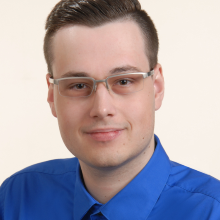Kontakt
Pfaffenwaldring 55
70569 Stuttgart
Deutschland
Raum: 0.727
M.Sc. Daniel Dittmann:
2025
- M. Dyballa, Z. Li, and D. Dittmann, “Boron vs. aluminum in ZSM-5 zeolites: Solid-state NMR, acidity, and C1/C2 reactant conversion,” Microporous and Mesoporous Materials, vol. 381, p. 113353, Jan. 2025, doi: 10.1016/j.micromeso.2024.113353.
- D. Dittmann, A. Ileri, D. Strassheim, and M. Dyballa, “Higher BTEX aromatic yield from ethanol over desilicated H,Zn-AlZSM-5 catalysts,” Catal. Sci. Technol., vol. 15, Art. no. 4, 2025, doi: 10.1039/D4CY01062K.
2024
- E. Kaya, D. Dittmann, M. Schmidt, and M. Dyballa, “Cu(dppf) complexes can be synthesized from Cu-exchanged solids and enable a quantification of the Cu-accessibility by 31P MAS NMR spectroscopy,” Dalton Trans., vol. 53, Art. no. 15, 2024, doi: 10.1039/D4DT00147H.
- J. H. Matthies, D. Dittmann, M. Dyballa, U. Tuttlies, and U. Nieken, “Investigation of Aging Mechanism of Pt‐ZSM‐5 Catalysts for Non‐Oxidative Propane Dehydrogenation,” Chemie Ingenieur Technik, vol. 96, Art. no. 6, May 2024, doi: 10.1002/cite.202300167.
- J. H. Matthies, D. Dittmann, M. Dyballa, U. Tuttlies, and U. Nieken, “Investigation of Aging Mechanism of Pt‐ZSM‐5 Catalysts for Non‐Oxidative Propane Dehydrogenation,” Chemie Ingenieur Technik, vol. 96, Art. no. 6, May 2024, doi: 10.1002/cite.202300167.
- E. Kaya, D. Dittmann, M. Schmidt, and M. Dyballa, “Cu(dppf) complexes can be synthesized from Cu-exchanged solids and enable a quantification of the Cu-accessibility by 31P MAS NMR spectroscopy,” Dalton Trans., vol. 53, Art. no. 15, 2024, doi: 10.1039/D4DT00147H.
2023
- D. Dittmann, E. Kaya, and M. Dyballa, “Desilicated ZSM-5 Catalysts: Properties and Ethanol to Aromatics (ETA) Performance,” ChemCatChem, Sep. 2023, doi: 10.1002/cctc.202300716.
- M. Schnierle et al., “How Solid Surfaces Control Stability and Interactions of Supported Cationic CuI(dppf) Complexes─A Solid-State NMR Study,” Inorganic Chemistry, vol. 62, Art. no. 19, May 2023, doi: 10.1021/acs.inorgchem.3c00351.
- D. Dittmann, E. Kaya, D. Strassheim, and M. Dyballa, “Influence of ZSM-5 Crystal Size on Methanol-to-Olefin (MTO) vs. Ethanol-to-Aromatics (ETA) Conversion,” Molecules, vol. 28, Art. no. 24, 2023, doi: 10.3390/molecules28248046.
- D. Dittmann, C. Rieg, Z. Li, E. Kaya, and M. Dyballa, “Better Performance in C2-Conversion to Aromatics by Optimized Feed and Catalysts,” Energy & Fuels 2023, 37, 6, vol. 37, Art. no. 6, Mar. 2023, doi: 10.1021/acs.energyfuels.3c00356.
- D. Dittmann, J. Schröder, E. Kaya, J. Mosrati, A. M. Abdel-Mageed, and M. Dyballa, “„Quantifiable Surface Methoxy Groups on Zr(OH) Groups of UiO-66 Metal–Organic Framework: Generation from Methanol-13C and Reactivity“,” The Journal of Physical Chemistry C, vol. 127, Art. no. 38, Sep. 2023, doi: 10.1021/acs.jpcc.3c04544.
- J. H. Matthies, D. Dittmann, M. Dyballa, and U. Nieken, “Slow aging mechanisms in non-oxidative reaction conditions e.g. dehydrogenation on Pt-ZSM5 catalysts,” Chemical and process engineering, Art. no. 3, Sep. 2023, doi: 10.24425/cpe.2023.146734.
2022
- Z. Li, D. Dittmann, C. Rieg, M. Benz, and M. Dyballa, “Hydronium ion and water complexes vs. methanol on solid catalyst surfaces: how confinement influences stability and reactivity,” Catal. Sci. Technol., vol. 12, Art. no. 16, 2022, doi: 10.1039/D2CY00829G.
- C. Rieg et al., “Introducing a Novel Method for Probing Accessibility, Local Environment, and Spatial Distribution of Oxidative Sites on Solid Catalysts Using Trimethylphosphine,” The Journal of Physical Chemistry C, vol. 126, Art. no. 31, Aug. 2022, doi: 10.1021/acs.jpcc.2c04114.
- Z. Li, D. Dittmann, C. Rieg, M. Benz, and M. Dyballa, “Confinement and surface sites control methanol adsorbate stability on MFI zeolites, SBA-15, and a silica-supported heteropoly acid,” Catal. Sci. Technol., vol. 12, Art. no. 7, 2022, doi: 10.1039/D1CY02330F.
2021
- C. Rieg et al., “A Method for the Selective Quantification of Brønsted Acid Sites on External Surfaces and in Mesopores of Hierarchical Zeolites,” The Journal of Physical Chemistry C, vol. 125, Art. no. 1, 2021, doi: 10.1021/acs.jpcc.0c09384.
- Z. Li et al., “The alumination mechanism of porous silica materials and properties of derived ion exchangers and acid catalysts,” Mater. Chem. Front., vol. 5, Art. no. 11, 2021, doi: 10.1039/D1QM00282A.
- C. Rieg et al., “Quantitative Distinction between Noble Metals Located in Mesopores from Those on the External Surface,” Chemistry – A European Journal, vol. 27, Art. no. 68, 2021, doi: https://doi.org/10.1002/chem.202102076.
2020
- M. Dyballa et al., “Potential of triphenylphosphine as solid-state NMR probe for studying the noble metal distribution on porous supports,” Microporous and Mesoporous Materials, p. 109778, Oct. 2020, doi: 10.1016/j.micromeso.2019.109778.
|
seit 2021
|
Promotion am Institut für Technische Chemie
|
|
2018-2020
|
Master of Science: Untersuchung der Zugänglichkeit von Edelmetallen auf porösen Trägern durch Komplexierung mit Phosphanen, Universität Stuttgart
|
| 2015-2018 |
Bachelor of Science: Entwicklung von Methoden zur Bestimmung der Edelmetallverteilung auf Feststoffkatalysatoren, Universität Stuttgart
|


